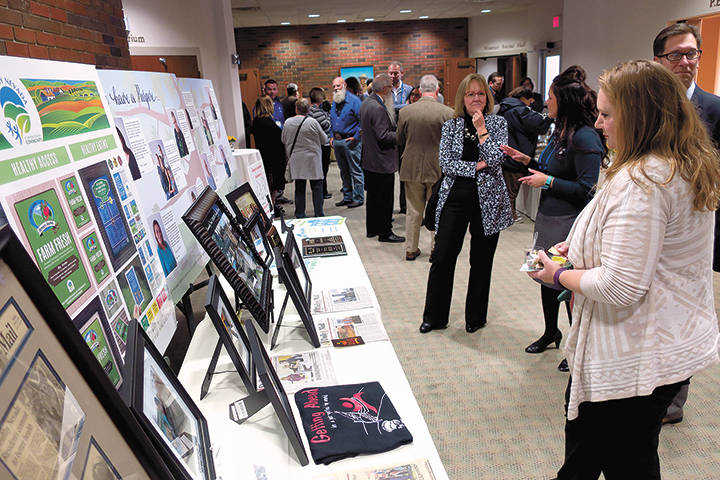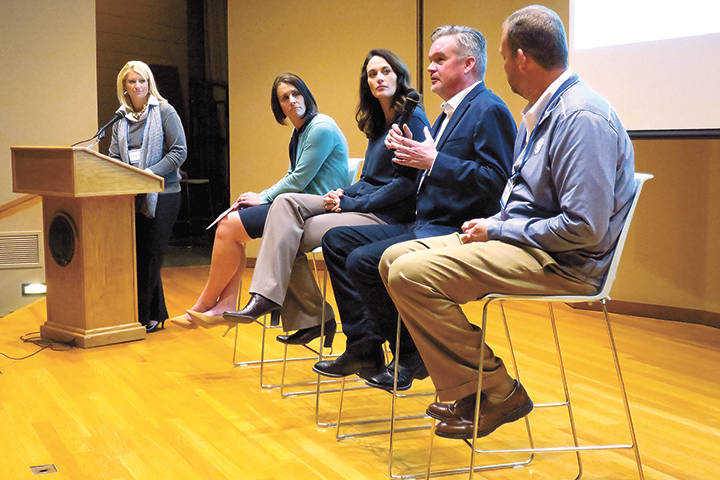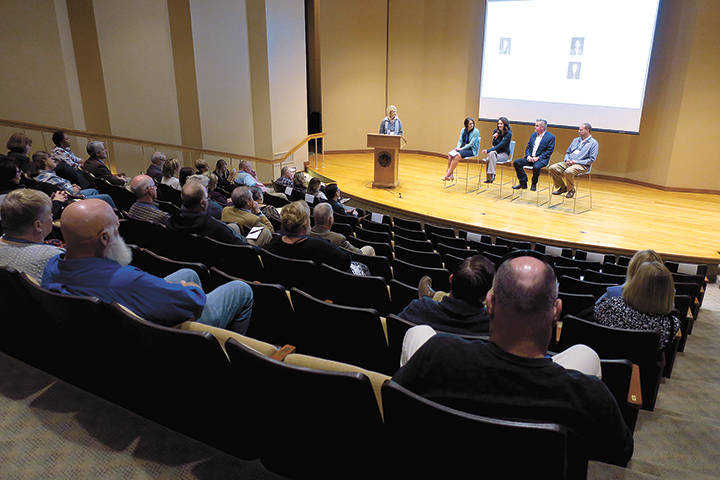Healthy Nevada celebrates fifth anniversary

On Thursday morning, Healthy Nevada hosted a public gathering at Cottey College in celebration of improved health rankings for Vernon County, its many health initiatives and served as a belated fifth birthday party. On hand for the festivities were some 40 people, including local staff and board members as well as representatives of its sponsoring organization, Cerner Corporation — an international supplier of health information technology — headquartered in Kanas City.
“This really isn’t about the board or staff but about the way the people across the community have come together and made such a huge positive impact on the health and wellness of people across the county,” said Kelly Ast, program coordinator of Healthy Nevada.
While launched in July 2012 as a five-year project to improve the health and well-being of Nevada and Vernon County residents, Healthy Nevada looks to continue for the foreseeable future even as it took time on Thursday to cite the progress for which it has served as a catalyst.

When it comes to population health management, the health demographics which are considered the most reliable are the numbers published for every county in the nation by the Robert Woods Johnson Foundation. Comparing the numbers for 2012 with 2017 shows that out of 115 (114 counties and the St. Louis city) Vernon County moved from a ranking of 88 to 60, a 24 percent improvement.
Even more dramatic is the improvement seen in the nine factors which together are termed health behaviors. These include rates of adult smoking, obesity and access to exercise opportunities. In health behaviors, Vernon County went from a rank of 104 in 2012 to this year being 52, which is a 45 percent improvement.
In an interview prior to the gathering, Healthy Nevada board chair, Alyson Harder, said, “I believe the key element in all this is our collaboration with our partners.”

In an after event interview with Nevada’s city manager, JD Kehrman spoke of Healthy Nevada’s work using the analogy of a silo. “Whether it’s me at the city or an employer, a church, community group or as individuals, we all get wrapped up in our own work, our own lives. And that’s the silo I’m talking about.”
He said Healthy Nevada has also been effective at identifying those people within the community who “get things done,” obtaining their buy-in either to the overall mission or to a project and then together, working to break down the silos.
Harder added, “Something else we did early on — which I think is key is — everywhere we went, we asked people what they saw as the needs. That’s why one of the first things we took on was food security which led to the community gardens and the farmers’ market. And look at those; they’ve taken off and have a life of their own.”
Asked about the project she is most proud of, Harder named the half-mile walking trail constructed on land adjacent to the Nevada Middle School.
“The community identified that project and raised the money,” said Harder. “They totally owned that project. And that’s what I mean about Healthy Nevada being a catalyst.”
When the city manager speaks to other communities about population health management, Kehrman uses the walking trail as an example. He tells them, “You can’t own this,” meaning the city or even a small coalition cannot be doing all the work. He says the work of a small group fails to change a whole community’s culture and when the money runs out or people get tired, the work is not sustainable.
“It used to be people would say to me, the city ought to do this or do that,” said Kehrman. “But look at the walking trail. Now people come to me and suggest projects and who would make good partners. That’s not Healthy Nevada, that’s community ownership.”
While the 45-minute public presentation touted the significant rise in Vernon County’s overall health ranking and cited specific areas which recorded dramatic improvement, it failed to note the two areas in which the county’s ranking has fallen.
The first of these is called the social and economic factors. Comparing 2012 with 2017 rankings, Vernon County went from 66 to 70. The major factor here was a rise in the number of children in poverty.
The second area which failed to show gains is called physical environment. In this area, the county went from a rank of 35 down to 45. Problems with air, water and housing contributed to the decline.
Harder was asked if Healthy Nevada approaches the issue of adopting a healthy lifestyle as a Nanny State issue, that is, act as an institution or organization which tells people what is good or bad for them.
“Healthy Nevada is not about prescribing what a healthy lifestyle is because that’s different for every one of us,” said Harder.” But we’re about encouraging people to find their purpose in life and adopting a lifestyle which will enable that purpose to the fullest.”
She used the example of wanting to be around to watch the children walk across the stage at graduation or play with the grandchildren and not get out of breath.
“Whatever that purpose is for you, then maybe you want to start making some choices about how I can feel better and so, for example, be able to play on the floor and not get winded,” said Harder.
To which she quickly added, “Telling people what’s healthy or not doesn’t work, it just doesn’t. There has to be ownership. If I’m going to lose weight or get moving, I have to want it. Bugging people or using guilt might get them off the couch but it won’t last. And so, in all our work, that’s what Healthy Nevada is about, empowering people to lead their life.”
Healthy Nevada is one of four community partners with which Cerner Corporation is currently collaborating. The first was Winona, Minn.; the third is Harper County, Kan., while the most recent is the Delta Health Alliance in Mississippi.
“I feel very blessed to have worked with Cerner, to have them support this project,” said Harder. “For me, it was about them believing in our community and our ability to change. We can be vital. We can do things. We don’t have to live in an urban area to really impact change and to find ways to improve population health.”
She did not deny or minimize the experiences of others but added, “From the knowledge and support they’ve given us, from my standpoint, I’m extremely grateful.”
Cerner’s original commitment to Healthy Nevada was for five years. In an interview prior to the event, Erik Gallimore, a senior director at Cerner, said: “Healthy Nevada is our living laboratory.”
He said Cerner recognizes Healthy Nevada has significant work yet to do. Further, the company desires to make Healthy Nevada a model which can be used in other communities.
Said Gallimore, “The tail of this project and its continuing evolution and what we want to go do is anywhere between five to 10 years.”
